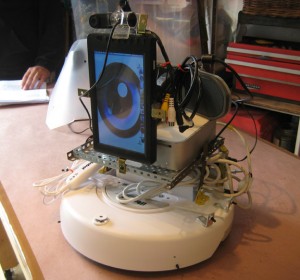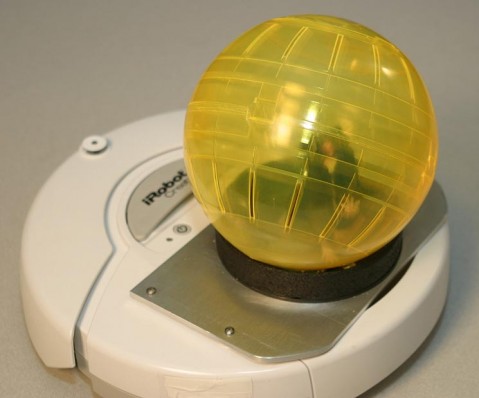 Sparky Jr. is a website dedicated to providing support for robot enthusiasts to create their own DIY telepresence robots. Telepresence (or TP, as insiders refer to it) is technology for enabling people to see and hear distant locations, usually through a computer screen. The Sparky Project takes it a step further by presenting a design for a robot that can provide a mobile platform for telepresence. This platform uses Skype for the video connection, a Mac Mini for the brains, and an iRobot Create to get around. After that, you just need a battery, some speakers, a microphone, webcam, and some other miscellaneous hardware, and you’re ready to go.
Sparky Jr. is a website dedicated to providing support for robot enthusiasts to create their own DIY telepresence robots. Telepresence (or TP, as insiders refer to it) is technology for enabling people to see and hear distant locations, usually through a computer screen. The Sparky Project takes it a step further by presenting a design for a robot that can provide a mobile platform for telepresence. This platform uses Skype for the video connection, a Mac Mini for the brains, and an iRobot Create to get around. After that, you just need a battery, some speakers, a microphone, webcam, and some other miscellaneous hardware, and you’re ready to go.
The Sparky Jr website hosts instructions, software, parts lists, and templates, as well as a forum, member pages, and instructional videos. Among other places, the Sparky project has been featured in Make Magazine, Modern Marvels, the San Francisco MOMA, and the San Jose Museum of Art.
The man behind Sparky Jr is Marque Cornblatt. I got the opportunity to ask Marque some questions about the Sparky project. Here it is.
RVC: It looks like you standardized on the iRobot Create for a base. Why?
The original bot had a custom welded base and drive train from a motorized wheelchair. Â This is a big, fast and robust platform, but heavy and tricky to build for many people. Â The Create is a great, inexpensive platform that is easy to work with lightweight, sensor-laden and versatile. Â I looked at other, more “serious” robot platforms, but they cost many hundreds or thousands of dollars.
RVC: While we’re on the topic of standards, why the Mac OS?
I use PCs and Macs but prefer Mac. Â the choice of the Mac Mini onboard the bot sealed the deal. Â Sparky will have a PC version of the software soon so users can choose their own preference.
RVC: We are already seeing telepresence robots in industrial, law enforcement and military applications. Mostly in cases where it is too dangerous to send humans. Do you see any different future applications that may be just around the corner? (Especially applications for consumers?)
Like so much new tech, it gets developed and deployed for military and law enforcement first and eventually trickles down to consumers.  Telepresence is the same.  Ultimately I see TP uses in educational environments, museums (as tour guides) and a wide range of social and entertainment activities.  Maybe the biggest use is for chatting with and interacting with babies and young children when the parent is at work or on vacation.  Sparky would never be a complete babysitter, but can allow a distant parent to get face-to-face with the child on the floor and chat from anywhere in the world.  That is a powerful tool for parents.
RVC: It seems like there are already some off-the-shelf telepresence packages available, or coming soon. Can you tell us advantages of building a Sparky Jr. over one of those?
Over the years, I’ve watched as several companies tried to bring TP to consumers (HeadThere, Anybot, Rovio, ConnectR, Spykee). Â These products usually fall into 2 categories:
1) WAY too expensive. Â With prices ranging from $5000-$250,000 Â Sparky costs aprox. $1000 to build
2) Underpowered. Â Many support 1-way video only or only present a still image, which is not as useful as true face-to-face video communication.
Also, these off-the-shelf bots offer nothing in the way of user customization. Â The Sparky design can be almost any size or shape bot the user wants (hint: Â Wait until Apple releases their tablet and you’ll see a new Sparky design soon afterwards).
RVC: How much use does the Sparky Jr. software make of the iRobot Create’s sensor data?
Sparky uses the bumper and edge data to control movement. Â The bot will override a drive command if the bumpers are activated or senses an edge or staircase. Â Also, we add new features all the time. Â Next up is homing so the bot can find the recharging base without human intervention, and some autonomous routines for home security (imagine Sparky roaming the house while you’re at work. Â It records any unusual movement or activity and actually emails of Skypes you with live updates).
RVC: Can you build a Sparky Jr. on a Roomba vacuum cleaner, or is it better to use a iRobot Create for the platform?
I believe that any roomba with a serial connection (most of them) will work. Â You may need to dissasemble part of the shell to access it on some models. Â Others have a convenient removable cover. Â Another nice aspect of the Create is that there is extra space where the vacuum guts would go. Â This extra space is filled with components that would otherwise be strapped on and bulging.
RVC: Do you have any plans to add any sort of haptics to Sparky Jr? If so, what do you think would be the most useful application for haptics in telepresence?
I don’t, but I encourage others to experiment. Â The reason I stay away is about identity and technology. Â Generally, people want robots to “do their work” for them and many bots are being developed as workers (lifting, carrying, fetching). Â I have always viewed Sparky as an equal, not a servant and putting grippers or arms on the bot would encourage the use of Sparky as a labor-saving device. Â I hope to establish the idea that a machine-human hybrid is not subservient or inferior to organic people.
RVC: Any future plans or dreams of where to go with this project in the near future?
My ultimate goal with this project is to share it with others and build a community of user/makers.  That is why I set up Sparky Jr. with all open-source software and links to hardware and templates and videos.  Ultimately I hope to see a world full of custom build TP ‘bots based on the basic Sparky design.  Where the community takes the idea  is up to them, and I can’t wait to see some of the other versions that people come up with.
Many thanks to Marque for answering my questions. If you are interested in the project, you should go to the Sparky Jr. website, sign up, and take a look around. If you have a little extra time you should also check out another one of Marque’s websites, Guns ‘n’ Gardens.
